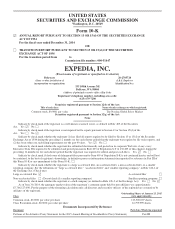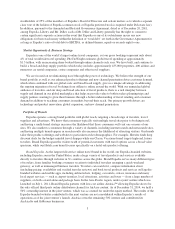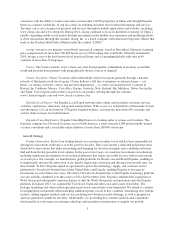Expedia 2014 Annual Report Download - page 13
Download and view the complete annual report
Please find page 13 of the 2014 Expedia annual report below. You can navigate through the pages in the report by either clicking on the pages listed below, or by using the keyword search tool below to find specific information within the annual report.websites are located at these facilities. For some critical systems, we have both production and disaster-recovery
facilities. Our technology systems are subject to certain risks, which are described below in Part I, Item 1A —
Risk Factors.
Competition
Our brands compete in rapidly evolving and intensely competitive markets. We believe the relatively low
percentage of total travel sales transacted online, particularly in international markets, indicates that these
markets represent especially large opportunities for Expedia and those of our competitors that wish to expand
their brands and businesses abroad to achieve global scale. We also believe that Expedia is one of only a few
companies that are focused on building a truly global, travel marketplace.
Our competition, which is strong and increasing, includes online and offline travel companies that target
leisure and corporate travelers, including travel agencies, tour operators, travel supplier direct websites and their
call centers, consolidators and wholesalers of travel products and services, large online portals and search
websites, certain travel meta-search websites, mobile travel applications, social media websites, as well as
traditional consumer eCommerce and group buying websites. We face these competitors in local, regional,
national and/or international markets. In some cases, competitors are offering favorable terms and improved
interfaces to suppliers and travelers which make competition increasingly difficult. We also face competition for
customer traffic on internet search engines and metasearch websites, which impacts our customer acquisition and
marketing costs. In addition, competitive pressure is particularly acute in China, where we operate primarily
through our majority-owned subsidiary, eLong. eLong has in the past and may also increasingly in the future
invest heavily in marketing as well as headcount to support their mobile product, technology and supply
development. They also engage in discounting and couponing activity. These actions are likely to result in
increasing operating losses in China as eLong attempts to grow market share and remain competitive.
We believe that maintaining and enhancing our brands is a critical component of our effort to compete. We
differentiate our brands from our competitors primarily based on the multiple channels we use to generate
demand, quality and breadth of travel products, channel features and usability, price or promotional offers,
traveler service and quality of travel planning content and advice as well as offline brand efforts. The emphasis
on one or more of these factors varies, depending on the brand or business and the related target demographic.
Our brands face increasing competition from travel supplier direct websites. In some cases, supplier direct
channels offer advantages to travelers, such as long standing loyalty programs, complimentary services such as
Wi-Fi, and better pricing. Our websites feature travel products and services from numerous travel suppliers, and
allow travelers to combine products and services from multiple providers in one transaction. We face competition
from airlines, hotels, rental car companies, cruise operators and other travel service providers, whether working
individually or collectively, some of which are suppliers to our websites. Our business is generally sensitive to
changes in the competitive landscape, including the emergence of new competitors or business models, and
supplier consolidation.
Intellectual Property Rights
Our intellectual property rights, including our patents, trademarks, copyright, domain names, trade dress,
proprietary technology, and trade secrets, are an important component of our business. For example, we rely
heavily upon our intellectual property and proprietary information in our content, brands, software code,
proprietary technology, ratings indexes, informational databases, images, graphics and other components that
make up our services. We have acquired some of our intellectual property rights and proprietary information
through acquisitions, as well as licenses and content agreements with third parties.
We protect our intellectual property and proprietary information by relying on our terms of use,
confidentiality procedures and contractual provisions, as well as international, national, state and common law
rights. In addition, we enter into confidentiality and invention assignment agreements with employees and
contractors, and license and confidentiality agreements with other third parties. Despite these precautions, it may
9
























